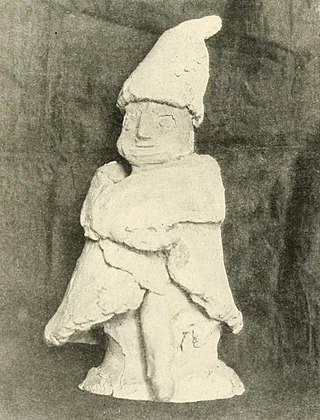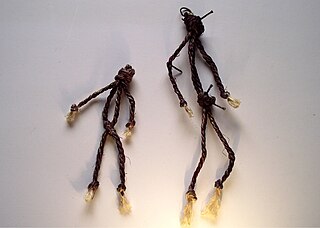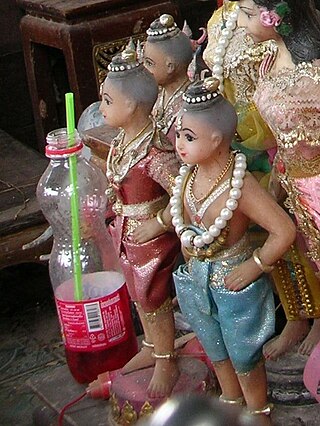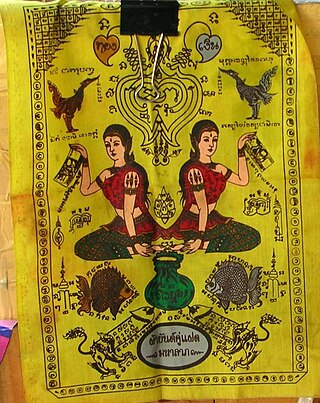
A kitchen witch, sometimes called a cottage witch [1] is a homemade poppet or doll resembling a stereotypical witch or crone displayed in residential kitchens as a good luck charm [2] and to ward off bad spirits. [3]

A kitchen witch, sometimes called a cottage witch [1] is a homemade poppet or doll resembling a stereotypical witch or crone displayed in residential kitchens as a good luck charm [2] and to ward off bad spirits. [3]
There is some debate over where the kitchen witch originated, some claiming Scandinavia and others Germany, [4] but consensus points to older Northern European customs, as it seems to have been more widespread earlier.
The poppet is supposed to depict a "good" [5] witch who inspires productivity and safety in a kitchen, but also counteracts any ill-will directed to the home. [6] It is considered good luck to give a kitchen witch to a friend or family member. So that those unfamiliar with the kitchen witch can understand its meaning, sometimes a note will be hung around the witch's neck [7] stating something similar to:
The Legendary Secret of Goof-Proof Cooking: The Famous Kitchen Witch
For centuries, Norwegians have hung this good witch in their kitchen. They believe she has the power to keep roasts from burning, pots from boiling over, and sauces from spilling.
Although largely unknown in modern England, the kitchen witch was known in England during Tudor times.
The will of John Crudgington, from Newton, Worfield, Shropshire in England, dated 1599, divides his belongings amongst his wife and three children, "except the cubbard in the halle the witche in the kytchyn which I gyve and bequeathe to Roger my sonne." [8] [9]

A doll is a model typically of a human or humanoid character, often used as a toy for children. Dolls have also been used in traditional religious rituals throughout the world. Traditional dolls made of materials such as clay and wood are found in the Americas, Asia, Africa and Europe. The earliest documented dolls go back to the ancient civilizations of Egypt, Greece, and Rome. They have been made as crude, rudimentary playthings as well as elaborate art. Modern doll manufacturing has its roots in Germany, from the 15th century. With industrialization and new materials such as porcelain and plastic, dolls were increasingly mass-produced. During the 20th century, dolls became increasingly popular as collectibles.

The evil eye is a supernatural belief in a curse brought about by a malevolent glare, usually inspired by envy. The belief in the evil eye among humans has existed since prehistory, and amulets to protect against it have been found dating to about 5,000 years ago. It is estimated that around 40% of the world's population believes in the evil eye.

A household deity is a deity or spirit that protects the home, looking after the entire household or certain key members. It has been a common belief in paganism as well as in folklore across many parts of the world.

A black cat is a domestic cat with black fur that may be a specific breed, or a common domestic cat of no particular or mixed breed. All-black fur pigmentation is slightly more prevalent in male cats than female cats. Most black cats have golden irises due to their high melanin pigment content. Black cats are the subject of myth, legend, and superstition. They are often associated with witches and bad luck in European folklore.

In some cultures, a rabbit's foot is carried as an amulet believed to bring good luck. This belief is held by people in a great number of places around the world, including Europe, China, Africa, Australia and North and South America. In variations of this superstition, the rabbit it came from must possess certain attributes, such as having been killed in a particular place, using a particular method, or by a person possessing particular attributes.

A witch bottle is a apotropaic magical item used as protection against witchcraft. They are described in historical sources from England and the United States. The earliest surviving mention is from 17th-century England.

A witch ball is a hollow sphere of glass. Historically, witch balls were hung in cottage windows in 17th and 18th century England to ward off evil spirits, witches, evil spells, ill fortune and bad spirits.

In folk magic and witchcraft, a poppet is a doll made to represent a person, for casting spells on that person or to aid that person through magic. They are occasionally found lodged in chimneys. These dolls may be fashioned from such materials as a carved root, grain or corn shafts, a fruit, paper, wax, a potato, clay, branches, or cloth stuffed with herbs with the intent that any actions performed upon the effigy will be transferred to the subject based on sympathetic magic. Poppets are also used as kitchen witch figures.

The cimaruta is an Italian folk amulet or talisman, traditionally worn around the neck or hung above an infant's bed to ward off the evil eye. Commonly made of silver, the amulet itself consists of several small apotropaic charms, with each individual piece attached to what is supposed to represent a branch of rue—the flowering medicinal herb for which the whole talisman is named, "cimaruta" being a Neapolitan form of cima di ruta: Italian for "sprig of rue".

Apotropaic magic or protective magic is a type of magic intended to turn away harm or evil influences, as in deflecting misfortune or averting the evil eye. Apotropaic observances may also be practiced out of superstition or out of tradition, as in good luck charms, amulets, or gestures such as crossed fingers or knocking on wood. Many different objects and charms were used for protection throughout history.

Gris-gris is a Voodoo amulet originating in West Africa which is believed to protect the wearer from evil or bring luck, and in some West African countries is used as a purported method of birth control. It consists of a small cloth bag, usually inscribed with verses from an ancestor and a ritual number of small objects, worn on the person.

Iron has a long and varied tradition in the mythology and folklore of the world.

An amulet, also known as a good luck charm or phylactery, is an object believed to confer protection upon its possessor. The word "amulet" comes from the Latin word amuletum, which Pliny's Natural History describes as "an object that protects a person from trouble". Anything can function as an amulet; items commonly so used include statues, coins, drawings, plant parts, animal parts, and written words.

Kuman Thong is a household divinity of Thai folk religion. It is believed to bring luck and fortune to the owner if properly revered. Kuman, or Kumara (Pali) means "Sanctified young boy" ; thong means golden.

A witch post is a local superstition where the cross of Saint Andrew is used as a hex sign on the fireplaces in Northern England, Yorkshire, and Lancashire, in order to prevent witches from flying down the chimney and entering the house to do mischief. By placing the St Andrew's cross on one of the fireplace posts or lintels, witches are thought to be prevented from entering through this opening. In this case, it is similar to the use of a witch ball, although the cross is supposed to actively prevent witches from entering, and the witch ball is supposed to passively delay or entice the witch, and perhaps entrap it.

Thai folklore is a diverse set of mythology and traditional beliefs held by the Thai people. Most Thai folklore has a regional background for it originated in rural Thailand. With the passing of time, and through the influence of the media, large parts of Thai folklore have become interwoven with the wider popular Thai culture.

Concealed shoes hidden in the fabric of a building have been discovered in many European countries, as well as in other parts of the world, since at least the early modern period. Independent researcher Brian Hoggard has observed that the locations in which these shoes are typically found – in chimneys, under floors, above ceilings, around doors and windows, in the roof – suggest that some may have been concealed as magical charms to protect the occupants of the building against evil influences such as demons, ghosts and witches. Others may have been intended to bestow fertility on a female member of the household, or been an offering to a household deity.
A hōko is a kind of soft-bodied doll given to young women of age and especially to pregnant women in Japan to protect both mother and unborn child. Traditionally, hōko dolls were made of silk and human hair, and stuffed with cotton. The dolls could be made for both boys and girls. Boys' dolls would be given up and "consecrated" at a shrine when boys came of age at 15 years old, while girls would give up their dolls at marriage. The dolls were given to children either at birth, or on special days shortly after birth. Pregnant woman would be given new ones, so as to protect her and her unborn child together, for the duration of the pregnancy.
{{cite book}}: CS1 maint: location missing publisher (link)